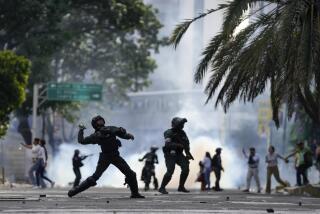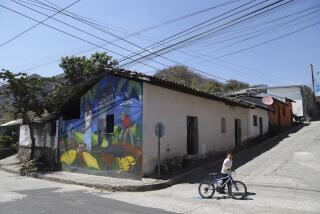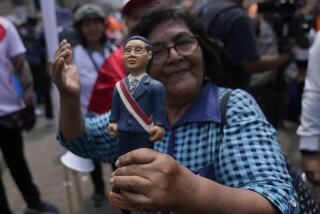THE FINAL CURTAIN : Where the Seeds of Ideology Never Reached Full Bloom : REGIONAL PERSPECTIVE: SOUTH AMERICA
- Share via
SANTIAGO, Chile — Alarms went off, sirens sounded. It was a little more than two decades ago, and the Soviet Union was invading the U.S. sphere of influence in South America, hoping to secure a Cold War beachhead on this vast and unruly continent.
Leftist governments in Peru, Chile and Bolivia tilted Kremlin-ward. To the glee of Communists and the horror of anti-Communists, the Soviets seemed clearly capable of putting their hammer-and-sickle brand on a South American country.
But it never happened. Indeed, in spite of some impressive early gains, the Soviet toehold in the region quickly gave way first to a period of rightist military rule and then to democratic reform.
In Chile, for example, the pro-Soviet Communist Party was a senior partner in Marxist President Salvador Allende’s 1970-73 government. And the Soviet Union did not hide its strong hope that Allende, a good friend of the Kremlin, would pave the way to socialism in Chile.
But then anti-Communist generals overthrew Allende and ruled for 16 1/2 years. The military regime imposed a free-market economic system that is still going strong under a civilian government in which socialists share power.
The Soviets never opened the billion-ruble spigots of aid for Chile as they did for Cuba. Moscow apparently was reluctant to take on the burden of massive aid to a country that was not yet a full-fledged member of the international Communist club. Instead, Soviet leaders urged Allende to maintain cordial relations with the United States, to steer a moderate course that would not overly alarm the Yankees. And within Allende’s coalition, the Communist Party was a model of moderation.
Like many South American Communist parties, the Chilean one was modeled along Soviet lines and had closely followed Moscow policy over the decades. The policy, with some periodical variations, was for Communists to seek power by working within “bourgeois” democratic systems.
That was a difficult order in South America during the 1950s, when U.S. influence reigned and only two countries, Argentina and Uruguay, maintained diplomatic relations with the Soviet Union. Many of the continent’s Communist parties were outlawed, but they continued to organize labor and students.
In the 1960s and 1970s, the Soviets helped finance some guerrilla movements secretly through Communist Cuba. “They used the Cubans as instruments,” observes Genaro Arriagada, secretary general of the Chilean Communist Party.
But Moscow’s main support in South America was for Communist parties in mainstream politics. Some political analysts argue that by channeling its relations on the continent through those often-marginal parties, the Soviet Union missed opportunities to exert more direct influence on non-Communist governments.
“That, in my judgment, was a great error,” said Arriagada.
Nevertheless, the Chilean Communist Party, restored to legality in 1964 after years of being outlawed, rapidly became the third-most-powerful Communist Party in the West--ranking after those of Italy and France--drawing up to 17% of the popular vote and sharing national power under Allende.
That was the peak of Soviet influence in South America. While Allende was in power, Moscow also enjoyed unprecedented successes in neighboring Peru and Bolivia.
In Peru, radical military officers seized power in 1968, and under Gen. Juan Velasco Alvarado began a revolutionary process that included increasingly warmer relations with the Soviet Union. Francisco Tudela, deputy director of the Institute for International Studies at the Catholic University of Peru, said Peruvian generals tried to use their ties with the Soviets as a lever with the United States.
“It was a way of saying to the United States, ‘Look, if you don’t help me, I will go over to the other side,’ ” Tudela said. “The relationship with the Soviet Union became very deep, because Peru really drifted away from the United States.”
Cementing its Peruvian ties during the 1970s, Moscow provided the South American country with hundreds of battle tanks and other major military weaponry. Analysts wondered: Was a Moscow-Havana-Lima axis in the making?
When the Soviet Union built a huge and costly fishing terminal for Peru at Paita, some worried that it would be used as a Soviet naval base, challenging U.S. strategic interests in South America. The challenge never came. Soviet-Peruvian ties cooled after the army relinquished power in 1980, and the matter was forgotten.
In Bolivia, a copy-cat coup by radical officers in 1970 also tripped alarms. Moscow made new aid and trade commitments to Bolivia as the country swung sharply left under Gen. Juan Jose Torres. A countercoup in 1971 cut short the pro-Soviet regime, but Moscow pragmatically continued to honor its commitments.
In Chile, Peru and Bolivia, as well as the rest of South America, the Soviet goal never seemed to be the rapid establishment of another Cuba. Instead, Moscow attempted to erode Washington’s influence and power without provoking any major “imperialist” reaction.
As its footholds in Bolivia, Chile and Peru successively collapsed, the Soviet Union clearly was on a downhill slide in South America. The late 1970s became a time of right-wing military rule on most of the continent. Although the generals in charge of Argentina and Brazil were not as fiercely anti-Soviet as Chile’s Augusto Pinochet, they gave no quarter to Moscow-line Communist parties.
When democracy began sweeping through South America in the 1980s, relations with the Soviet Union improved. Local Communist parties were legalized and several South American presidents made trips to Moscow.
In 1987, then Foreign Minister Eduard A. Shevardnadze visited Brazil, Argentina and Uruguay. The trip was seen as a new, “de-ideologized” approach to South America by Moscow under Mikhail S. Gorbachev’s glasnost policy.
And that was the only kind of approach that seemed worthwhile. Although anti-Communist military regimes were disappearing in South America, free-market economic policies were becoming predominant, and Moscow-line Communist parties were in eclipse.
Voices
“Socialism is Soviet power plus the electrification of the whole country.”
--Vladimir Ilyich Lenin, Dec. 22, 1920
“It is a riddle wrapped in a mystery inside an enigma. . . .”
--Winston Churchill, English statesman, Oct. 1, 1939
More to Read
Sign up for Essential California
The most important California stories and recommendations in your inbox every morning.
You may occasionally receive promotional content from the Los Angeles Times.










